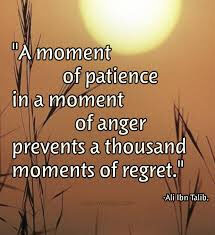Overcome Anger with Patience
 Patience is key to overcoming suffering, pain and anger. It is challenging to know what to do when one feels anger and aggression. We can suppress anger or act it out by being passive or aggressive. Either way it only makes the situation worse for ourselves and others. The other healthy way to deal with anger is to practice patience and be assertive: wait, experience and process the anger and investigate its nature and then act wisely while respecting your needs and other people needs.
Patience is key to overcoming suffering, pain and anger. It is challenging to know what to do when one feels anger and aggression. We can suppress anger or act it out by being passive or aggressive. Either way it only makes the situation worse for ourselves and others. The other healthy way to deal with anger is to practice patience and be assertive: wait, experience and process the anger and investigate its nature and then act wisely while respecting your needs and other people needs.
The Buddhist teachings describe patience as the antidote to anger and aggressive attitude. Raw feelings of aggression and its behaviors manifest themselves in many forms – resentment, bitterness, rage, being critical, abusive and complaining, passive-aggressive, and so on.
When we experience strong feelings that produce negative energy, there is a discomfort that pushes us to create some resolution. It hurts to feel the “aggressive” feelings and there is a strong need to resolve it. This is why we become aggressive, hit back and retaliate. This hurtful feeling and negative energy is so tough that it hijacks our brain and forces it to act. When you act, in order to break away from the pain of aggression, you create escalation, more aggression and more pain.
If we were train ourselves to be able to catch ourselves early enough, or to do the right thing regardless of the emotion, we would be able to see that underneath the raw anger, there is a mechanism that can benefit us. For that we need to understand the anger mechanism and as mentioned, be patient. Unfortunately, most times, most people find themselves in the middle of a burning, noisy, exciting situation that is provocative and triggers an immediate (equally) strong response that has a aggressive quality to it. At that point, patience means being wise: you stop and wait. Don’t talk or even say a word, because if you say anything, your tone will reveal your state and it is going to come out the wrong way as it has a negative energy to it.
When you wait, you need to wait wisely. Don’t wait with the thought of retaliation afterward. Don’t wait ruminating on how wrong the other person is. Don’t wait and plan your retaliation or punishment. All negative thoughts will act against your patience. Your patience also requires you to see the reality as is yet being non-judgmental about it. It does not mean to deny or suppress your anger, but rather accept it as a fact. It is accepting your feelings as is, treating them gently with care without feeding your anger with discursive thoughts.
The process of being patient can be challenging and even torturous, because you feel bad (angry/guilty) about being angry, while you are, in fact, angry, and you can’t drop it. It is a painful experience, with confusion of thoughts, feelings, needs and wisdom. Still, you need to wait and remain patient with your confusion, the desire to react and the pain that comes with it. Until you reach the internal peace, you need to push yourself to wait and not react, even though inside you are reacting. This process requires the power to face the feeling and act (or not act) wisely despite the feelings of anger and suffering. That entails a fearless attitude and tremendous courage.
By being patient and courageous, you get deep into yourself and get to know the anger mechanism and how it breeds aggressive actions. Like in a movie that you watch, as an outsider and not being involved, you watch the whole process without acting it out. You will be able to feel the energy of anger, and you will know where it leads. Yet, you will contain yourself and stay still, without going there.
Developing patience and fearlessness means learning to sit still with the edginess of the energy. It’s like sitting on a wild horse, or on a wild tiger that could eat you up. There’s a limerick to that effect: “There was a young lady of Niger, who smiled as she rode on a tiger. They came back from the ride with the lady inside and the smile on the face of the tiger.” Sitting with your discomfort feels like riding on that tiger, because it’s so frightening.
When we examine this process we realize that anger has no resolution. The classical resolution that human beings try to apply when facing a (an external) problem is by removing the problem/obstacle or avoiding it. However, this strategy cannot be applied to psychological or mental challenges. We cannot remove our thoughts or feelings. We need to learn to transform its energy from a deeper level of acceptance and wisdom.
We want to believe that we have the power to control things, including control of our emotions and as such when we feel negative powerful energy, we tend to be extremely uncomfortable until things are resolved. We want to do something about it. It is hard for us to live with ambiguity as it is not black and not white not right and not wrong, not good and not bad. It is hard for us to be in a no man’s land, while having no attachment to anything. But the practice of patience gives us nothing to hold on to. It increases our ability to be without resolution and to accept ambiguity and uncertainty.
Actually, the eastern philosophical teachings themselves give us nothing to hold on to. The resolution is temporary and just causes more suffering. The teachings explain that happiness, peace and harmony start and finish by being at home with yourself; sitting still with the moodiness of the energy until it rises, dwells and passes away. The energy never resolves itself, but rather transforms itself. The transformation depends on what we do with it. When we try to resolve anger, the negative energy amplifies, while being patient reduces the negative energy of anger.
Patience is also not ignoring. In fact, patience and curiosity go together. You wonder, Who am I? Who am I at the level of my neurotic patterns? Who am I at the level beyond birth and death? If you wish to look into the nature of your own being, you need to be inquisitive. The path is a journey of investigation, beginning to look more deeply at what’s going on. The teachings give us a lot of suggestions about what we can look for, and the practice give us a lot of suggestions on how to look.
While patience is helpful and promotes self and spiritual growth, aggression, on the other hand, prevents us from looking inside ourselves and as such promotes unhealthy habits. If you embrace loss, irritation, resentment, jealousy, anger or any kind of pain, you will recognize that underneath the pain there is always something we are attached to. There is always something we are holding on to.
If you apply patience, you can let go of your attachment, including your anger. Patience helps you to get to the point of letting go gradually – at a very sane and loving pace, at the speed that your basic wisdom allows you to move. It’s a big moment even to get to the point where you realize you have a choice. Patience is what you need at that point to just wait and soften, to sit with the restlessness, edginess and discomfort.
Patience helps you move from where you are to where you want to be. It is the bridge between where you are and what you aspire to be. It promotes acceptance and humility without being judgmental and critical of yourself. You need to be gentle and have a delicate care for your own imperfections, for your own limitations, for not living up to your own high ideals. There’s a slogan someone once came up with that I like: “Lower your standards and relax as it is.” That’s patience.
One of the Indian Buddhist teacher Atisha’s slogans says, “Whichever of the two occurs, be patient.” It means that if a painful situation occurs, be patient, and if a pleasant situation occurs, be patient. This is an interesting point in terms of patience and the cessation of suffering, patience and fearlessness, and patience and curiosity. We actually jump all the time: whether it’s from pain or pleasure, we want resolution. So if we’re really happy and something is great, we should also be patient then, in terms of not just filling up the space, going a million miles an hour—impulse buying, impulse speaking, impulse acting.
Patience is difficult, yet it is a positive and supportive practice lead to spiritual transformation. It’s the way to develop courage, the way to find out what life is really about.
Please visit author, Moshe Ratson at his google+ Profile: +Moshe Ratson





